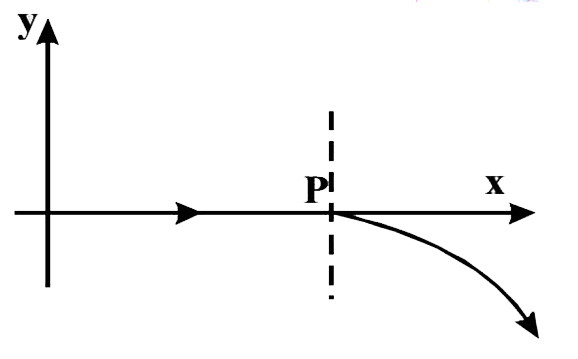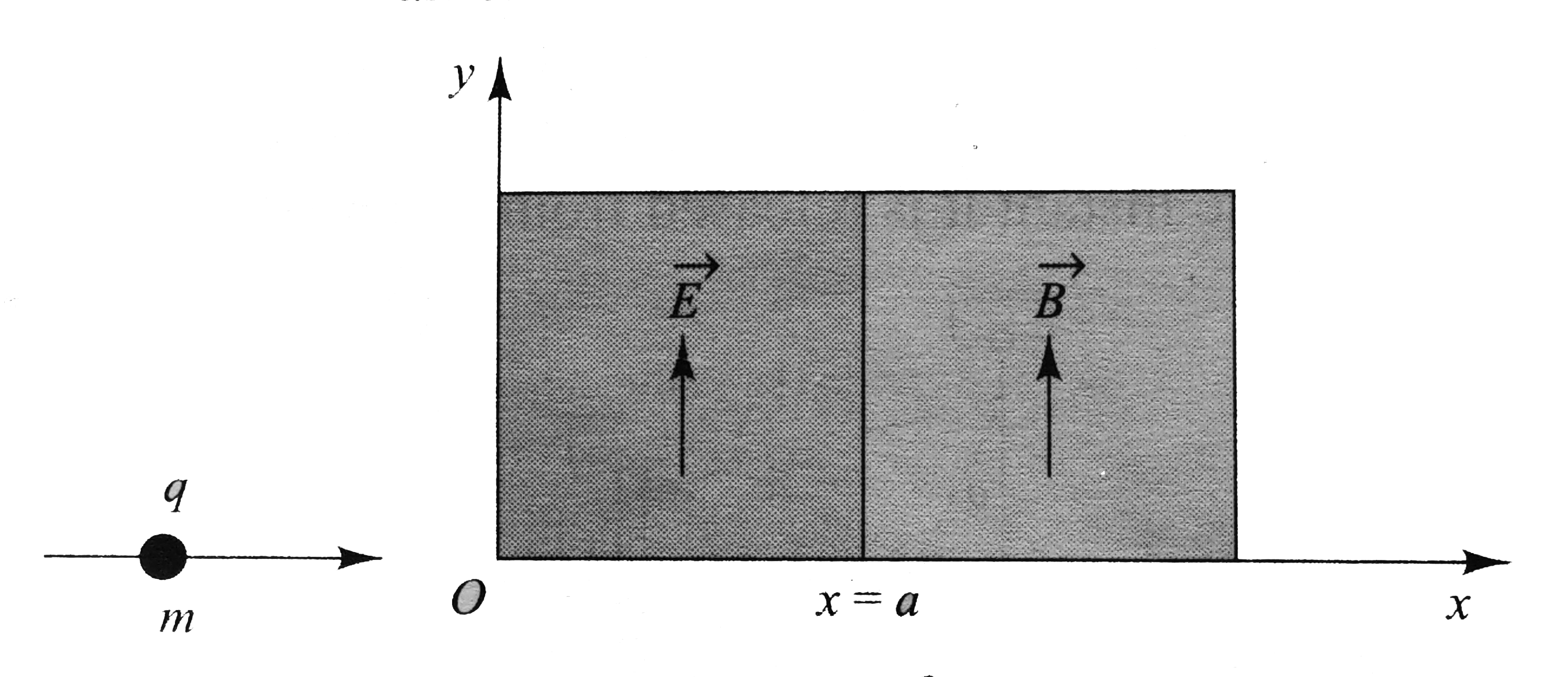For a positively charged particle moving in a x−y plane initially along the x−aξs , there is a sudden change in its path due to the presence of electric and//or magnetic fields beyond p . The curved path is shown in the x−yplane and is found to be non - circular. Which one of the following combinations is possible ?

→E=0,→B=bˆi+cˆk
→E=ai,→B=cˆk+aˆi
→E=0,→B=cˆj+bˆk
→E=ai,→B=cˆk+bˆj
The correct Answer is:B
Electric field can deviate the path of the particle in the shwon direction only when it is along negative y-direction. In the given options →E is either zero or along x-direction. Hence it is the magnetic field which is really reponsible for its curved path. Options (a) and (c) can't be accepted as the path will be helix in that case (when the velocity vector makes an angle other than o∘,180∘ or 90∘ with the magnetic field, path is a helix) options (d) is wrong beacuse in that case component of net force on the particle also comes in k direction which is not acceptable as the particle is moving in x−y plane. Only in option (b) the particle cam move in x−y palne.
In option (d) :→Fnet=q→E+q(→v×→B)
Initial velocity is along x-direction. So let →v=vˆi
∴→Fnet=qaˆi+q[(vˆi)×(cˆk+bˆj)]qaˆi−qvcˆj+qvbˆk
In option (b)
→Fnet=q(aˆi)+q[(vˆi)×(cˆk+aˆi)=qaˆi−qvcˆj]
Topper's Solved these Questions
- SOURCE AND EFFECT OF MAGNETIC FIELDBook:A2ZChapter:SOURCE AND EFFECT OF MAGNETIC FIELDExercise:Force On A Current Carrying Conductor In Magnetic Field
Explore 42 Videos
- SOURCE AND EFFECT OF MAGNETIC FIELDBook:A2ZChapter:SOURCE AND EFFECT OF MAGNETIC FIELDExercise:Magnetic Dipole
Explore 32 Videos
- SEMICONDUCTOR ELECTRONICSBook:A2ZChapter:SEMICONDUCTOR ELECTRONICSExercise:EXERCISE
Explore 29 Videos
- WAVE OPTICSBook:A2ZChapter:WAVE OPTICSExercise:Section D - Chapter End Test
Explore 29 Videos
Similar Questions
An electron in moving along positive x-axis in the presence of uniform magnetic field along positive y-axis. What is the direction of the force acting on it ?
View SolutionAn electrons is moving along +ve x-axis in the presence of uniform magnetic field along +ve y-axis. What is the direction of the force acting on it?
View Solution
Knowledge Check
A positively charge particle moving along x-axis with a certain velocity enters a uniform electric field directed along positively y-axis. Its
AVertical velocity changes but horizontal velocity remains constantBHorizontal velocity changes but vertical velocity remiand constantCBoth vertical and horizontal velocities changeDNeither vertical nor horizontal velocity changes.A charged particle moves along a circle under the action of possible constant electric and magnetic fields. Which of the following are possible?
AE=0,B=0BE=0,B≠0CE≠0,B=0DE≠0,B≠0x and y co-ordinates of a particle moving in x−y plane at some instant of time are x=2t and y=4t.Here x and y are in metre and t in second. Then
The path of the particle is a…….Astraight lineBparabolaCcircleDellipse
A particle moves in the the x−y Plane according to the scheme x−8sinπt, where t is time. Find equation to the path of the particle. Show the path on a graph.
View SolutionA positively charged particle, having charge q, is accelerated by a potential difference V. This particle moving along the x-axis enters a region where an electric field E exists. The direction of the electric field is along positive y-axis. The electric field exists in the region bounded by the lines x=0andx=a. Beyond the line x=a (i.e., in the region x>a), there exists a magnetic field of strength B, directed along the positive y-axis. Find

a. at which point does the particle meet the line x=a.
b. the pitch of the helix formed after the particle enters the region x≥a. (Mass of the particle is m.)
View SolutionA charged particle moves along a circle under the action of passible constant electric and magnetic fields. Which of the following are possible?
View SolutionA particle of mass m and positive charge q is projected with a speed of v0 in y–direction in the presence of electric and magnetic field are in x–direction. Find the instant of time at which the speed of particle becomes double the initial speed.
View SolutionA point mass is moving in the x-y plane. Its acceleration is a constant vector perpendicular to the x-axis. Which of the following do/does not charge with time ?
View Solution
